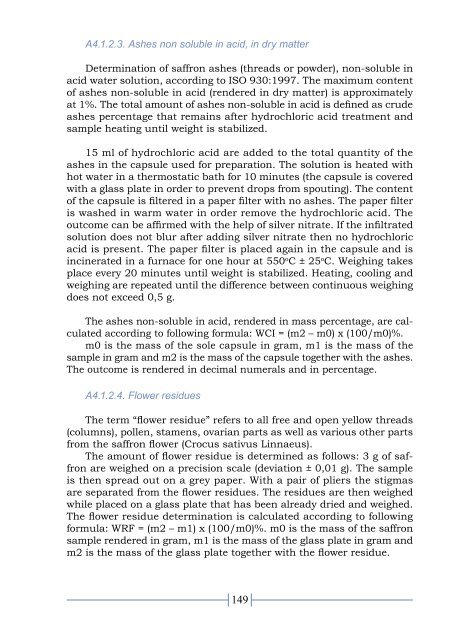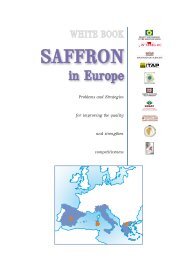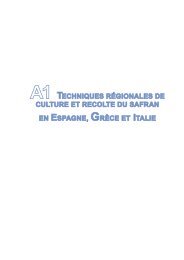Annex White book.pdf
Annex White book.pdf
Annex White book.pdf
Create successful ePaper yourself
Turn your PDF publications into a flip-book with our unique Google optimized e-Paper software.
A4.1.2.3. Ashes non soluble in acid, in dry matterDetermination of saffron ashes (threads or powder), non-soluble inacid water solution, according to ISO 930:1997. The maximum contentof ashes non-soluble in acid (rendered in dry matter) is approximatelyat 1%. The total amount of ashes non-soluble in acid is defined as crudeashes percentage that remains after hydrochloric acid treatment andsample heating until weight is stabilized.15 ml of hydrochloric acid are added to the total quantity of theashes in the capsule used for preparation. The solution is heated withhot water in a thermostatic bath for 10 minutes (the capsule is coveredwith a glass plate in order to prevent drops from spouting). The contentof the capsule is filtered in a paper filter with no ashes. The paper filteris washed in warm water in order remove the hydrochloric acid. Theoutcome can be affirmed with the help of silver nitrate. If the infiltratedsolution does not blur after adding silver nitrate then no hydrochloricacid is present. The paper filter is placed again in the capsule and isincinerated in a furnace for one hour at 550 o C ± 25 o C. Weighing takesplace every 20 minutes until weight is stabilized. Heating, cooling andweighing are repeated until the difference between continuous weighingdoes not exceed 0,5 g.The ashes non-soluble in acid, rendered in mass percentage, are calculatedaccording to following formula: WCI = (m2 – m0) x (100/m0)%.m0 is the mass of the sole capsule in gram, m1 is the mass of thesample in gram and m2 is the mass of the capsule together with the ashes.The outcome is rendered in decimal numerals and in percentage.A4.1.2.4. Flower residuesThe term “flower residue” refers to all free and open yellow threads(columns), pollen, stamens, ovarian parts as well as various other partsfrom the saffron flower (Crocus sativus Linnaeus).The amount of flower residue is determined as follows: 3 g of saffronare weighed on a precision scale (deviation ± 0,01 g). The sampleis then spread out on a grey paper. With a pair of pliers the stigmasare separated from the flower residues. The residues are then weighedwhile placed on a glass plate that has been already dried and weighed.The flower residue determination is calculated according to followingformula: WRF = (m2 – m1) x (100/m0)%. m0 is the mass of the saffronsample rendered in gram, m1 is the mass of the glass plate in gram andm2 is the mass of the glass plate together with the flower residue.149




